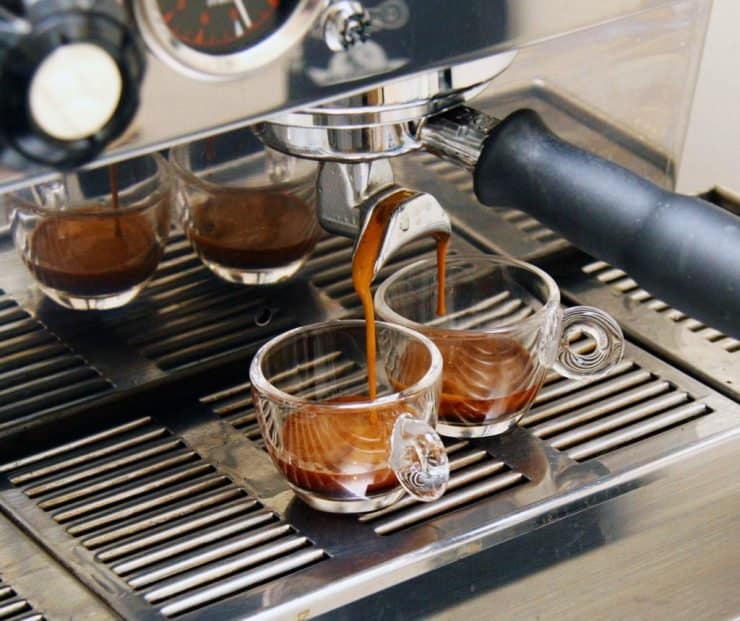Coffee Brewing Methods: Unlocking the Keys to the Perfect Cup at Home
Coffee Brewing Methods: Unlocking the Keys to the Perfect Cup at Home
Blog Article
The Science Behind Coffee Brewing: Exactly How Temperature and Time Affect Your Drink
Understanding the science behind coffee developing reveals that temperature level and time are not plain variables but critical components that determine the beverage's flavor profile and overall high quality. The ideal developing temperature level usually falls in between 195 ° F and 205 ° F, while the period of extraction varies considerably across different techniques. This interaction of factors can cause a cup that is either disappointing or delightful. As we explore the subtleties of these aspects, the question develops: exactly how can one effectively balance temperature level and time to attain that best brew?
The Chemistry of Coffee Extraction
The chemistry of coffee removal looks into the detailed procedures that transform raw coffee beans right into the fragrant beverage delighted in worldwide. This change primarily involves the solubility of numerous compounds existing in the beans, which are influenced by variables such as work dimension, water quality, and the developing method used.
Throughout the brewing process, warm water functions as a solvent, extracting soluble substances, including caffeine, sugars, lipids, and acids, from the coffee premises. Each substance adds to the flavor profile, fragrance, and body of the last beverage. Acids are responsible for intense and zesty notes, while oils add to a rich mouthfeel.
The initial stages of brewing extract acids and sugars, leading to a pleasurable acidity, while long term removal can lead to resentment due to over-extraction of unwanted compounds. Comprehending these chemical communications is crucial for optimizing brewing techniques, as the balance in between removal time and water temperature level can considerably influence the total top quality of the coffee.
Perfect Brewing Temperatures
Discovering the ideal brewing temperature level is necessary for unlocking the full capacity of coffee flavors and fragrances - coffee brewing methods. Research shows that the optimal range for developing coffee lies between 195 ° F to 205 ° F(90 ° C to 96 ° C) Within this range, the removal procedure effectively liquifies the desirable soluble compounds in coffee beans, causing a savory and balanced cup
Developing at lower temperature levels, such as listed below 195 ° F(90 ° C ), may result in under-extraction, generating an acidic and weak mixture with low-key tastes. On the other hand, developing at temperatures going beyond 205 ° F(96 ° C) can bring about over-extraction, producing a rough and bitter preference due to the extreme dissolution of unfavorable substances, such as tannins.
Moreover, the ideal developing temperature level can differ depending upon the coffee bean kind and roast level. As an example, lighter roasts typically gain from somewhat greater temperature levels to enhance their complicated taste profiles, while darker roasts might be much better fit to lower temperature levels to minimize anger.
Inevitably, preserving precision in developing temperature levels is vital for attaining a harmonious equilibrium of tastes, ensuring that every mug of coffee supplies a satisfying sensory experience.
Impact of Brewing Time
Brewing time plays a crucial role in establishing the flavor account and total top quality of coffee. The extraction process, which influences the taste, aroma, and body of the drink, is mainly dependent on exactly how long the coffee premises are in contact with water. Much shorter brewing times can lead to under-extraction, leading to a weak or sour flavor, as not sufficient soluble compounds are liquified. Alternatively, long term brewing can bring about over-extraction, where unfavorable substances are launched, leading to an astringent or bitter preference.
Ideal developing time differs depending on the approach utilized and the grind size of the coffee. A French press usually needs regarding four mins, while coffee extraction is typically completed within 25 to 30 secs. It is necessary to calibrate developing time in combination with various other variables, such as water temperature and coffee-to-water proportion, to attain the desired taste account.
Comprehending the influence of brewing time makes it possible for coffee lovers to improve their brewing strategies, ultimately enhancing the sensory experience of their mug (coffee brewing methods). With mindful focus to this variable, one can open the complete potential of the coffee, revealing its one-of-a-kind attributes and nuances
Developing Approaches and Their Impacts

For example, methods like French press and chilly brew enable a much longer steeping time, causing a fuller body and durable taste because of raised removal of oils and soluble solids. Alternatively, coffee developing makes use of high stress and a much shorter removal time, creating a concentrated shot that highlights intense flavors and an abundant crema.
Pour-over strategies, such as Chemex or V60, supply an even more regulated extraction process, allowing the brewer to adjust circulation price and water distribution, which can enhance brightness and quality. Percolation techniques cycle water with the coffee grounds numerous times, leading to a more powerful, commonly bitter flavor.
Lastly, making use of paper filters versus steel filters can likewise impact the last taste; paper filters typically yield a cleaner cup by capturing oils and great particles, while steel filters enable more oils to pass through, adding to a fuller mouthfeel - coffee brewing methods. Comprehending these nuances can boost the coffee experience substantially
Tips for Refining Your Mixture
A well-executed brew can change even the easiest coffee right into an amazing experience. Grind the beans simply before brewing to make best use of freshness, making certain the grind size matches your developing method-- coarser for French press and finer for espresso.
Water top quality plays an important duty; use filteringed system water devoid of pollutants. The excellent brewing temperature varies in between 195 ° F and 205 ° F(90 ° C to 96 ° C ) Too hot can swelter the coffee, while also awesome might under-extract tastes.
Timing is just as essential. For immersion techniques, soaking for 3 to 5 minutes is optimal, whereas drip techniques commonly take about five minutes. Try out mixture times to discover your favored toughness.

Conclusion
In summary, the detailed connection between temperature level and time is vital in the coffee brewing procedure. Comprehending these scientific concepts equips people Continued to fine-tune their brewing strategies, eventually leading to a more well balanced and pleasurable coffee experience.
Recognizing the scientific research behind coffee brewing exposes that temperature and time are not simple variables but essential elements that determine the beverage's flavor account and general top quality. Comprehending these chemical communications is important for optimizing brewing strategies, as the balance in between removal time and water temperature can dramatically influence the general quality of the coffee.Brewing time plays a crucial role in figuring out the taste profile and general top quality of coffee. By focusing on these aspects-- bean top quality, grind size, water temperature, soaking time, and proportion-- you can elevate your coffee brewing procedure, resulting in a consistently exceptional mug.
In recap, the intricate connection in between temperature level and time is paramount in the coffee brewing process.
Report this page